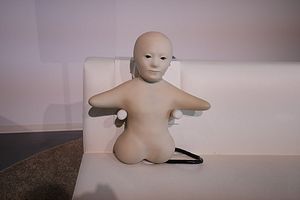Japan’s artificial intelligence expertise is transforming the elder care industry, with niche robotic caregiving accomplishing more than just taking pressure off the critical shortage of caregivers. Senior care facilities across Japan are testing out robots that deliver an assortment of social and physical health care and the government-backed initiative has been met with positive reviews by elderly residents.
Japan’s rapidly graying population is being eyed by the government as a lucrative market for medical technology. Dismal government projections show that by 2025, Japan’s first baby boomers will have turned 75 and 7 million people will be suffering from some form of dementia. The nation won’t be able to avert a dementia crisis without an additional 380,000 senior care workers.
The chronic shortage of professional care workers has encouraged the Japanese government to simplify procedures for foreign caregivers to get trained and certified. The current Technical Intern Training Program between Vietnam, the Philippines, and Indonesia under an Economic Partnership Agreement was extended to include nursing care as well as agriculture, fishery, and construction sectors.
Despite the government’s move to bolster the numbers of senior care workers, the target number of foreign graduates has fallen flat, with the national caregiver examination proving a major hurdle to pass. The success rate for foreign students was a measly 106 students in 2016, which slightly improved to 216 students in 2017. Another grim reality is that 19 to 38 percent of foreign nurses who pass the exam opt to leave the industry and return home, citing tough work conditions and long hours.
This is where the government believes care robots will be able to step in.
Shintomi Nursing Home in the heart of Tokyo is making international headlines for being home to 20 models of care robots, mimicking cute furry animals, small children, human shaped “humanoids,” or full-sized lifting and walking robots. The government-funded project took off in 2013 but five years on residents have taken a shine to their robotic companions. A research study by the Japan Agency for Medical Research and Development announced the results showed that, with robot care, seniors’ autonomy, sociability, mood, and communication improved along with a better quality of life over all.
A nationwide survey by private elder care company Orix Living found that 80 percent of respondents over 40 welcomed or were open to being helped by a care robot. Respondents revealed a common fear of becoming a burden on family members and explained feeling more relaxed in the presence of a robot.
The most visually unusual form in the catalog of care robots is the “Telenoid.” At first glance it looks like a bald, expressionless, unfinished robot from a horror movie. But the Telenoid, which mimics the gestures as well as broadcasting the voice of remotes users, was intentionally designed to be unisex, ageless, and easy to hug in a person’s lap. In spite of first impressions, the Telenoid robot specializes in friendly communication for dementia patients who live alone or in nursing homes. The goal is to improve communication with family and staff as well as serving as conversation stimuli.
The robot is maneuvered remotely using an external tablet and the robot’s mouth and head moves to mimic conversation. From a psychological standpoint the austere exterior encourages recipients to harness the power of imagination to envision the Telenoid as a positive image of the person they are actually talking to — or someone they want to talk to. One resident from Shintomi Nursing Home explained that talking with a robot eased the anxiety of overthinking what the other person is thinking during conversation, making participants more inclined to speak freely and share feelings.
The range of rehabilitation robots also includes Aibo, the pet dog robot, and Paro, a robotic baby harp seal that delivers emotional responses, producing similar effects to those found in animal therapy. For a conversation partner the 30cm Robohon and CommU robots feature a fast speech recognition function geared for simple conversation and “baby talk” responses.
While Japan tends to be slow at adopting bold public policies, it has been quick to get on board with kick-starting subsidies for care robot innovation. Although the industry is still in its early stages, generating only $16 million annually, the robotic business industry is projected to triple in revenue by 2065. However, a major setback remains the price of Telenoids and humanoids, which ranges from $3,800 to $8,000 each.

































